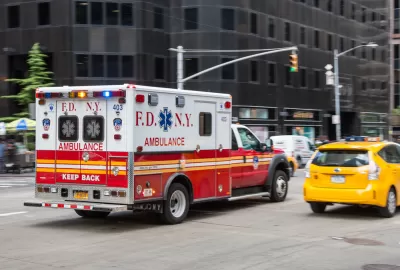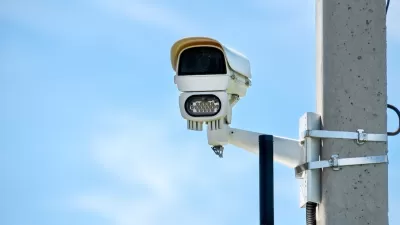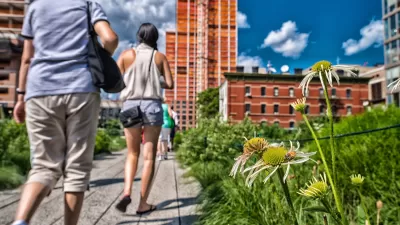Are the needs of emergency response vehicles inconsistent with nondrivers’ needs for slower, safer streets? Maybe not.

One common argument against efforts to create street space for bicycles and other nondrivers is that emergency response vehicles such as ambulances need to drive very fast in case someone has a heart attack, and that therefore all streets should be as wide as possible so that ambulances can drive as fast as 100 miles per hour. But wide streets create a variety of negative side effects: by facilitating fast automotive traffic, they increase the number of fatal crashes, since a car hitting a pedestrian (or another driver) at 50 miles an hour is more likely to cause death than a car traveling 20 miles per hour. In addition, wider streets, by facilitating fast traffic, also encourage long commutes, thus increasing suburban sprawl, which in turn increases vehicle miles traveled and a wide variety of other vehicle-related externalities such as increased greenhouse gas emissions.
Thus, the “emergency response” argument in favor of wide streets only makes sense if the risk of death from a too-slow ambulance outweighs the risk of death from a speeding car. Since over 40,000 Americans died in car crashes last year, this claim seems hard to believe.
But even if this were the case, the needs of emergency vehicles do not support American street design policies that encourage wide roads, fast traffic, and suburban sprawl. Why? Because if we really wanted to get other cars out of the way of ambulances, we would minimize vehicle miles traveled. For example, let’s suppose that instead of extending 50 or 60 miles from downtown, metropolitan Atlanta’s 6 million people lived at Manhattan densities (averaging about 70,000 people per square mile) and lived on narrower, more walkable streets. If this was the case, all of metro Atlanta would fit into an area slightly smaller than Brooklyn (97 square miles). Presumably, traffic would move more slowly, which would be bad for ambulances. So at first glance, it might seem that our hypothetical Atlanta would be far worse for ambulance service than the status quo.
On the other hand, in this scenario, more people would walk or use public transit, so ambulances would not have to compete with as many cars for street space. (Admittedly, they would have to compete with walkers and cyclists—but these groups take up less street space than cars). More importantly, ambulances would not have to travel nearly as far: a quick look at a map of Brooklyn suggests that no one lives more than a mile or two from the nearest hospital. By contrast, in some Atlanta exurbs, the nearest hospital is nine or ten miles away. So the time ambulances would lose in speed they would gain in reduced distance.
Moreover, if we really want to protect ambulances from being slowed down by automobiles, we might want to keep the rest of the citizenry out of cars by giving them other ways of getting around, such as subways and bike lanes. Here, the needs of ambulances are actually consistent with the needs of nondrivers.
Similarly, if we really wanted to make ambulances fast, we wouldn’t have a street network that looks like that of a typical Sun Belt suburb. In many newer suburbs, nearly all residential streets are cul-de-sacs. As a result, most automobile traffic is funneled into a few major commercial streets, thus making those streets unnecessarily congested.
If we really wanted to speed up ambulances, we would put residential streets on a grid, so that ambulances could avoid motorists who were trying to reach offices and stores. Here too, the needs of ambulances are consistent with the needs of nondrivers: with gridded streets, people who want to reach one residential street from another residential street should be able to walk between those streets without having to go to a congested, high-speed commercial street.
In sum, it is occasionally argued that the needs of ambulances are inconsistent with the needs of nondrivers, because ambulances benefit from fast traffic, and nondrivers are safer with slow traffic. But in fact, the interests of ambulance drivers and nondrivers may not be so far apart.

Study: Maui’s Plan to Convert Vacation Rentals to Long-Term Housing Could Cause Nearly $1 Billion Economic Loss
The plan would reduce visitor accommodation by 25,% resulting in 1,900 jobs lost.

Alabama: Trump Terminates Settlements for Black Communities Harmed By Raw Sewage
Trump deemed the landmark civil rights agreement “illegal DEI and environmental justice policy.”

Why Should We Subsidize Public Transportation?
Many public transit agencies face financial stress due to rising costs, declining fare revenue, and declining subsidies. Transit advocates must provide a strong business case for increasing public transit funding.

Paris Bike Boom Leads to Steep Drop in Air Pollution
The French city’s air quality has improved dramatically in the past 20 years, coinciding with a growth in cycling.

Why Housing Costs More to Build in California Than in Texas
Hard costs like labor and materials combined with ‘soft’ costs such as permitting make building in the San Francisco Bay Area almost three times as costly as in Texas cities.

San Diego County Sees a Rise in Urban Coyotes
San Diego County experiences a rise in urban coyotes, as sightings become prevalent throughout its urban neighbourhoods and surrounding areas.
Urban Design for Planners 1: Software Tools
This six-course series explores essential urban design concepts using open source software and equips planners with the tools they need to participate fully in the urban design process.
Planning for Universal Design
Learn the tools for implementing Universal Design in planning regulations.
Smith Gee Studio
Alamo Area Metropolitan Planning Organization
City of Santa Clarita
Institute for Housing and Urban Development Studies (IHS)
City of Grandview
Harvard GSD Executive Education
Toledo-Lucas County Plan Commissions
Salt Lake City
NYU Wagner Graduate School of Public Service






























